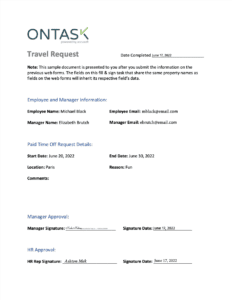You’re a construction project manager facing a complex renovation where hidden structural issues could dramatically change your scope of work. You analyze the existing framework and realize adjustments are needed to ensure safety and building code compliance.
In other words, more time and money are out of the scope of this project. In this scenario, a cost-plus contract is your best ally because it’s flexible in addressing unforeseen expenses and changes in project requirements.
A cost-plus contract is a pricing agreement where the contractor is reimbursed for all direct project costs (materials, labor, and equipment) plus an additional agreed-upon fee or percentage for overhead and profit. This contract type is particularly valuable in construction and engineering projects where the full scope of work isn’t easily determined upfront.
Continue reading to learn everything you need to know about cost-plus contracts: how they work, their different types, key advantages and disadvantages, and how they compare to other contract types. We’ll even show you how to automate contract creation so you don’t have to do it manually every time.
How Do Cost-Plus Contracts Work In Construction Projects?
Think of a cost-plus contract as a transparent partnership where every dollar spent is accounted for. Unlike traditional contracts, where contractors may need to pad their estimates to cover uncertainties, cost-plus contracts lay everything bare on the table.
Here’s how the dollars and cents break down:
Direct Costs
- Materials: Every nail, beam, and brick
- Labor: Wages for workers on site
- Equipment: From heavy machinery rentals to small tool purchases
- Subcontractor fees: Any specialized work needed
Indirect Costs
- Project management and supervision
- Office overhead
- Insurance and bonds
- Administrative expenses
The “plus” part? That’s where the contractor’s profit comes in, typically structured as either a fixed fee or a percentage of the total costs. Following our contract creation guide, you can ensure all these elements are properly documented.
Managing the Money Flow
Throughout the project, contractors submit detailed documentation for all expenses, usually including:
- Weekly or monthly cost reports
- Original receipts and invoices
- Time sheets for labor
- Equipment usage logs
Project Owner’s Perspective
Here’s how a project owner can benefit from a cost-plus contract:
- Real-time visibility into all project costs
- Right to audit expenses
- Ability to make informed decisions about changes
- Need for careful budget monitoring
Contractor’s Perspective
And here are the benefits of a cost-plus contract for contractors:
- Reduced financial risk
- Guaranteed profit margin
- Higher administrative burden
- Need for meticulous record-keeping
Trust and transparency is what makes cost-plus contracts a success. Both parties must maintain open communication and detailed documentation throughout the project lifecycle.
The Different Types Of Cost-Plus Contracts
So, you want to use a cost-plus contract for your construction contract management. But there’s more than one type — which should you choose? Let’s break down each to see which matches the needs of your next project.
Cost-Plus Fixed Fee (CPFF)
With a cost-plus fixed fee contract, the contractor gets reimbursed for costs plus a predetermined flat fee. Simple and straightforward.
For example, let’s say you have a $1M renovation project with a fixed fee of $100,000. Even if costs rise to $1.2M, the contractor’s fee remains $100,000.
This type of contract is best for projects with well-defined scopes but uncertain costs, like historical building renovations.
Cost-Plus Incentive Fee (CPIF)
The cost-plus incentive fee contract combines cost reimbursement with performance-based incentives. In other words, the better the contractor performs, the higher the fee.
For instance, a contractor who completes a project under budget gets to keep 50% of the savings, creating motivation for cost efficiency.
CPIF is best for complex projects where innovation and efficiency matter, like green building initiatives.
Cost-Plus Award Fee (CPAF)
A cost-plus award fee contract is similar to CPIF, but with subjective performance criteria. The difference: fees are awarded based on periodic evaluations.
For example, a contractor earns additional fees for exceptional safety records, quality metrics, or timeline adherence.
This makes CPAF best for government contracts or projects with multiple success metrics beyond just cost.
Cost-Plus Percentage of Cost (CPPC)
In a cost-plus percentage of cost contract, the contractor’s fee is a percentage of the total costs. Warning: This type is actually illegal in many public contracts due to potential abuse.
It works like this: A 15% fee on all costs means higher project costs = higher contractor profits. See the problem?
Because of this, CPPC is rarely recommended due to misaligned incentives, but is sometimes used in emergency situations.
Pro Tip: When selecting a cost-plus contract, make sure it aligns contractor incentives with project goals. Match the contract type to your project’s priorities: cost control, performance, or flexibility.
The Advantages Of A Cost-Plus Contract
When implemented correctly, construction contract agreements can create win-win scenarios for both project managers and contractors. Let’s explore the key benefits that make cost-plus contracts particularly attractive.
Flexibility in Design & Requirements
Cost-plus contracts shine when project scope needs room to breathe. Take a historical building renovation — you may discover original architectural features worth preserving only after work begins. With a cost-plus contract, you can:
- Adjust specifications on the fly
- Add or modify design elements
- Incorporate unexpected discoveries
- Respond to changing market conditions
Key takeaway: Cost-plus contracts let you adapt to reality instead of being locked into initial assumptions.
Reduced Contractor Risk
Contractors can focus on quality execution rather than padding estimates to cover uncertainties. Real-world example: A contractor discovering asbestos during demolition can immediately address the issue without lengthy change order negotiations.
Other benefits include:
- Direct reimbursement for unexpected costs
- No need to inflate initial bids
- Protection against material price fluctuations
- Clear documentation of all expenses
Key takeaway: Lower risk means more competitive initial pricing and fewer disputes.
Encourages Project Collaboration
Unlike fixed-price contracts that can create adversarial relationships, cost-plus arrangements promote teamwork.
Here’s how it plays out in practice:
- Open discussions about cost-saving opportunities
- Shared problem-solving when issues arise
- Transparent communication about budget impacts
- Aligned interests in project success
For example, when a supplier raises prices mid-project, both parties can work together to source alternatives or adjust specifications to stay on budget.
Key takeaway: Shared transparency leads to better solutions and smoother project execution.
The Disadvantages Of A Cost-Plus Contract
Cost-plus contracts offer significant benefits, but they’re not without challenges. Let’s explore the potential pitfalls that project managers and contractors should carefully consider when implementing construction contract management strategies.
Potential for Cost Overruns
You’re halfway through a major office renovation when your contractor submits invoices for premium materials you hadn’t anticipated. Since they’re getting reimbursed for all costs plus their fee, there’s limited incentive to hunt for better deals or manage expenses aggressively.
This scenario plays out more often than you may think. Without proper controls, contractors might not feel the pressure to negotiate with suppliers or optimize resource allocation. A $500,000 project can quickly balloon to $750,000 when there’s no financial motivation to keep costs in check.
Smart project managers combat this by establishing clear budget guidelines and regular review processes. Building in cost control mechanisms from day one keeps everyone aligned and focused on financial efficiency.
Increased Administrative Burden
Managing a cost-plus contract can feel like running a small accounting firm. Every receipt, every hour worked, every piece of equipment used needs to be meticulously documented and verified. For contractors, this means dedicating significant resources to tracking and reporting expenses. Project managers find themselves spending countless hours reviewing and approving these detailed submissions.
Consider a medium-sized commercial build. Your project manager might spend 15-20 hours per week just reviewing cost documentation — time that could be spent managing the project. Meanwhile, your contractor needs dedicated staff just to maintain the paper trail.
The solution lies in adopting digital systems and clear documentation protocols from the start. The administrative load becomes more manageable when everyone knows exactly what to track and how to report it.
Lack of Cost Certainty
One of the toughest pills to swallow with cost-plus contracts is the inability to nail down a final price tag. Unlike fixed-price contracts, you’re essentially writing a blank check — albeit one with some controls in place. This uncertainty can wreak havoc on budgeting and financial planning.
For example, imagine a contractor starting a warehouse expansion project with a rough estimate of $2 million. Six months in, they’re looking at $2.5 million with no end in sight. Supply chain issues, labor shortages, and scope adjustments all contributed to the climbing costs.
The most successful projects counter this uncertainty by establishing detailed cost monitoring systems and regular budget reviews. Setting clear milestones and implementing a robust change management process keeps costs from spiraling while maintaining the flexibility that makes cost-plus contracts attractive in the first place.
Remember, these disadvantages don’t make cost-plus contracts a poor choice — they just require careful planning and proactive management to ensure success. Understanding these challenges upfront and putting systems in place to address them before they become issues are key.
A Cost-Plus Contract Template
Ever tried to write a cost-plus contract from scratch? Not easy the first, second, or even third time. That’s why we’ve gathered some excellent examples of what these contracts typically look like in the real world.
Before we show you these templates, let’s break down the essential elements that any solid cost-plus contract should include:
- Project Scope Definition
- Clear definition of direct and indirect costs
- Indirect Cost Allowances
- Specified fee structure (fixed fee or percentage)
- Documentation requirements
- Payment terms and schedule
- Audit rights
- Change order procedures
- Dispute Resolution Process
Here’s another example showing a variation of a cost-plus contract from SignNow:
Remember, even when using a template (yes, even ours) it’s always wise to have your final contract reviewed by legal counsel, especially for larger projects. Think of templates as the foundation — you still need to build the house that fits your specific needs.
Want to learn more about automating your contract creation process? Check out our guide on how to automate contract creation to save time and reduce errors.
A Cost-Plus Contract vs A Lump Sum Contract
Cost-plus and lump sum contracts price construction projects differently. For instance, a cost-plus contract reimburses all project costs plus a fee. Then a lump sum contract locks in a fixed price upfront, no matter what happens during construction.
Key Differences
To help you make the best choice for your project, let’s break down what sets apart these two contract types.
Cost-Plus Contract
- Reimbursement: Contractor gets reimbursed for actual costs plus an agreed fee
- Scope: Flexible scope and adjustable budget
- Cost Tracking: Detailed cost tracking required
- Bid Prices: Lower initial bid prices
- Best For: Complex or uncertain projects
Lump Sum Contract
- Price Structure: One fixed price for the entire project
- Scope: Rigid scope with formal change orders needed
- Cost Tracking: Minimal cost tracking required
- Bid Prices: Higher initial bid prices (risk premium built in)
- Best For: Simple, well-defined projects
When to Choose Each Type
Not sure which to select? Let’s explore when each type makes the most sense, so you can make an informed decision for your next construction project.
When to Choose Cost-Plus:
- Renovating historic buildings with unknown conditions
- Fast-tracked projects starting before design completion
- Complex projects with a high chance of scope changes
- When transparency and collaboration are priorities
- During periods of material price volatility
When to Choose Lump Sum:
- Building standard commercial spaces
- Projects with complete drawings and specifications
- When budget certainty is the top priority
- Simple renovations with a clear scope
- When minimal owner involvement is preferred
And for a visual representation of the differences, we put together these charts to show main differences and how it impacts project managers and contractors:
Practical Comparison
| Aspect | Cost-Plus | Lump Sum |
| Risk for Contractor | Low | High |
| Risk for Owner | High | Low |
| Cost Transparency | High | Low |
| Administrative Burden | High | Low |
| Flexibility | High | Low |
| Budget Certainty | Low | High |
For Project Managers
| Cost-Plus | Lump Sum |
| Complete cost transparency | Fixed price for entire project |
| Higher administrative burden | Simpler administration |
| Unlimited budget exposure | Known total project cost |
| Flexible scope management | Less scope flexibility |
| More change order flexibility | Formal change order process required |
For Contractors
| Cost-Plus | Lump Sum |
| Guaranteed profit margin | Risk of cost overruns |
| Lower financial risk | Higher financial risk |
| Higher documentation requirements | Less detailed cost tracking |
| Easier to accommodate changes | Limited profit upside |
| Full cost recovery | Potential for higher profits if managed well |
The bottom line: Choose cost-plus when flexibility and transparency matter most. Opt for lump sum when budget certainty is your primary concern. Neither contract type is inherently better — it’s about matching the contract type to your project’s specific needs.
A Cost-Plus Contract vs a Time and Materials Contract
These contracts may sound similar, but they have distinct differences that can significantly impact your project’s success. Let’s break down what sets them apart and when to use each one.
Key Differences
Understanding these core differences is just the start. To make the best choice for your project, consider specific scenarios where each contract type shines.
Cost-Plus Contracts:
- Cover all project costs plus a predetermined profit margin
- Include overhead expenses and indirect costs
- Often have more complex administrative requirements
- Profit is clearly defined upfront
- Usually better suited for larger projects
Time and Materials Contracts:
- Focus specifically on labor hours and material costs
- Typically use preset hourly rates that include profit
- Simpler tracking and administration
- Profit is built into the rates
- Better for smaller or short-term projects
When to Choose Each Type
While these guidelines provide a solid framework, seeing how these contracts perform in practice can really drive the point home. Let’s look at a detailed practical comparison that breaks down how each contract type handles different aspects of project management.
Choose Time and Materials When:
- You need work to start immediately
- The project scope is unclear but urgently needed
- You’re dealing with emergency repairs
- The work is expected to be short-term
- You want simpler administration
Choose Cost-Plus When:
- You need full transparency on all project costs
- The project is complex with many moving parts
- You want control over material selection
- The project timeline extends beyond a few months
- You need detailed cost documentation for stakeholders
Practical Comparison Table
| Factor | Time & Materials | Cost-Plus |
| Setup Speed | Fast | Slower |
| Administrative Load | Light | Heavy |
| Cost Transparency | Partial | Complete |
| Profit Structure | Built into rates | Separately defined |
| Best Project Size | Small to medium | Medium to large |
| Risk Level | Medium | Low for contractor, higher for owner |
For Project Managers
| Cost-Plus | Time and Materials |
| Covers all project costs | Focuses on labor hours and material costs |
| More complex administration | Simpler tracking and administration |
| Profit clearly defined upfront | Profit built into rates |
| Better for larger projects | Better for smaller or short-term projects |
| Full cost transparency | Partial cost transparency |
For Contractors
| Cost-Plus | Time and Materials |
| Guaranteed profit margin | Profit built into hourly rates |
| Covers overhead and indirect costs | May not cover all indirect costs |
| More detailed cost documentation | Less detailed cost tracking |
| Better for long-term projects | Ideal for short-term or urgent work |
| Flexibility in scope changes | Easier to start work immediately |
Note: Time and materials contracts work like a running taxi meter — you pay for time spent and materials used. Cost-plus contracts are more like an open book where every expense is visible and accounted for, plus a clear profit margin.
The right choice often depends on your project’s size, urgency, and how much administrative oversight you can handle. For quick repairs or small projects, time and materials often wins. For major construction or complex renovations, cost-plus typically provides better control and transparency.
A Cost-Plus Contract vs a Unit Price Contract
Unit price contracts charge fixed rates for specific work units (like $X per square foot of flooring), while cost-plus contracts reimburse actual costs plus a fee. This core difference shapes how each contract handles risk, pricing, and project management.
Key Differences
To make the best choice for your project, consider the nuances each one presents. Here’s an overview of what makes them unique.
Unit Price Contracts:
- Set prices for specific units of work upfront
- Payment based on actual quantities completed
- Easier to compare competitive bids
- Works well for repetitive, measurable tasks
- Less paperwork and administrative overhead
Cost-Plus Contracts:
- Reimburse actual costs plus an agreed fee
- Require detailed expense tracking
- Focus on total project costs
- Better for complex, variable work
- Higher administrative requirements
When to Choose Each Type
Understanding when to use each contract type can mean the difference between a smooth project and constant headaches. Let’s examine specific scenarios that call for each approach, based on real-world experience and project requirements.
Choose Unit Price When:
- Work can be broken into clear, measurable units
- You’re doing repetitive tasks (like road paving)
- You want to easily compare contractor bids
- Quantities may vary, but unit costs are stable
- You need simplified billing and verification
Choose Cost-Plus When:
- Work is complex or hard to quantify
- Project scope is uncertain
- You want full cost transparency
- Material prices are volatile
- Quality takes priority over the lowest bid
Practical Comparison
| Factor | Unit Price | Cost-Plus |
| Risk Distribution | Shared | Owner bears most |
| Cost Certainty | Medium | Low |
| Administrative Load | Low | High |
| Flexibility | Low | High |
| Best Project Type | Repetitive work | Complex projects |
| Bid Comparison | Easy | Difficult |
For Project Managers
| Cost-Plus | Unit Price |
| Reimburses actual costs plus fee | Set prices for specific units of work |
| Requires detailed expense tracking | Payment based on actual quantities completed |
| Focus on total project costs | Easier to compare competitive bids |
| Better for complex, variable work | Works well for repetitive, measurable tasks |
| Higher administrative requirements | Less paperwork and administrative overhead |
For Contractors
| Cost-Plus | Unit Price |
| Guaranteed profit margin | Profit built into unit prices |
| Lower financial risk | Shared risk between contractor and owner |
| Higher documentation requirements | Simpler cost tracking |
| Easier to accommodate changes | Less flexibility for scope changes |
| Full cost recovery | Potential for higher profits if efficient |
Bottom line: Choose a unit price contract when you have clearly defined, measurable work units and want simplified cost management. Opt for a cost-plus contract when dealing with complex projects where flexibility and transparency are crucial.
But situations aren’t black and white — the best contract type depends on your specific project needs, risk tolerance, and management capabilities.
Cost-Plus Contract vs a Guaranteed Maximum Price (GMP) Contract
Think of a GMP contract as a cost-plus contract with a ceiling. Both contracts reimburse actual costs plus a fee, but a GMP sets an upper limit on what the owner will pay — no matter what happens.
Key Differences
Let’s look at each of the factors that make a GMP contract unique from a CPC contract.
Cost-Plus:
- No maximum price limit
- Owner bears all cost risks
- Full reimbursement of costs plus fee
- Higher flexibility for changes
GMP:
- Fixed maximum price
- Shared cost risks
- Savings often split between parties
- Changes require formal amendments
When to Choose Each Type
Making the right choice between these contract types can significantly impact your project’s success. To help you visualize these differences more clearly, let’s see a side-by-side comparison.
Choose Cost-Plus When:
- Project scope is highly uncertain
- Speed matters more than cost certainty
- You want maximum flexibility
- Strong trust exists between parties
Choose GMP When:
- You need a maximum budget cap
- You want to incentivize cost savings
- Scope is reasonably well-defined
- Risk sharing is important
Practical Comparison Table
| Factor | Cost-Plus | GMP |
| Budget Control | Limited | Strong |
| Risk for Contractor | Low | Medium-High |
| Risk for Owner | High | Medium |
| Change Flexibility | High | Medium |
| Cost Savings Incentive | Low | High |
| Administrative Burden | High | Very High |
For Project Managers
| Cost-Plus | GMP |
| Complete cost transparency | Limited exposure to cost overruns |
| Higher administrative burden | Requires intensive initial planning |
| Unlimited budget exposure | Known maximum project cost |
| Flexible scope management | Less scope flexibility |
| More change order flexibility | Formal change order process required |
For Contractors
| Cost-Plus | GMP |
| Guaranteed profit margin | Risk of exceeding maximum price |
| Lower financial risk | Shared cost overrun risk |
| Higher documentation requirements | Complex initial estimating needed |
| Easier to accommodate changes | Limited profit upside |
| Full cost recovery | Potential cost absorption above GMP |
Cost-plus contracts are preferred when the project scope is unclear or likely to change, the speed to start is critical, or when material prices are volatile. They’re often used in projects like historic building renovations where unknown conditions could significantly impact scope and costs.
GMP contracts are ideal when budget certainty is important, scope is well-defined, and risk sharing is important. They’re commonly used for projects like new office building construction with complete architectural plans and specifications, where incentivizing cost savings is desired.
It also works best when paired with open-book accounting and regular cost reviews. This transparency helps prevent disputes and keeps everyone aligned on project goals.
Simplify Creating a Cost-Plus Contract With Docubee
Cost-plus contracts offer flexibility and transparency for construction projects with uncertain scopes or changing requirements. While they require detailed documentation and oversight, the right tools can transform this complex process into a streamlined operation.
Docubee’s construction contract management software helps you create, track, and manage cost-plus contracts efficiently. Our platform automates the documentation process, ensuring accurate cost tracking and transparent reporting.
With our Docubee document generation system, you can quickly create customized cost-plus contracts that meet your specific project needs. The platform handles everything from initial contract creation to ongoing cost monitoring and reporting.
Ready to simplify your cost-plus contract management? Contact Docubee today to learn how our solutions save time, reduce errors, and improve project oversight.


















